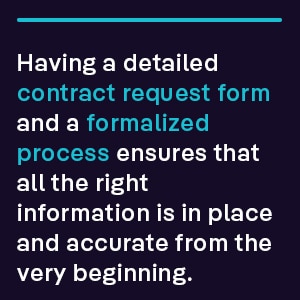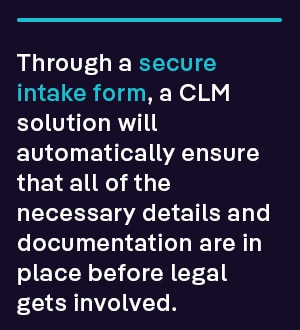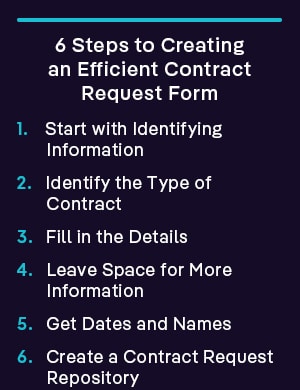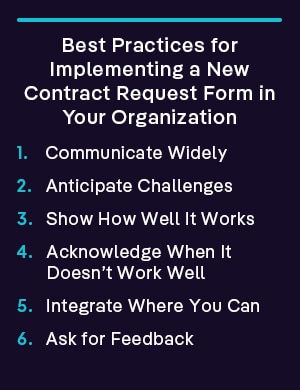Contracts harmonize every aspect of business, from customer and employee relationships to the way that data is used, and privacy is maintained.
As such, just about every department in the organization needs contracts to be in place — And when they do, they usually turn to the legal department to generate them.
Requesting contracts (whether for creation or review) are a necessary first step in the contract management lifecycle. But when requests come from across the business — sometimes in large numbers — legal teams can become overwhelmed. And when the actual contract request process is inefficient, they can spend too much of their time following up on inaccuracies and missing information, which wastes resources and increases costs. They can also spend far less time focusing on higher-value, strategic work.
That is why an efficient contract request process is so critical today. But for your request process to work, it needs to be easy to follow and communicated widely across the enterprise. And it needs to start with a contract request form that everybody will use.
Contract Request and Intake Process, and Why It Is Important
Although some folks may call it different things, the first step in the contract management lifecycle is the contract request. It outlines the details required in the contract itself, as well as the approval parties and any relevant dates that the legal team need to know. It also defines the type of contract that is necessary — whether it be an NDA, procurement contract, employment contract, or another agreement — and what should be included. Each type of contract will require different types of information or documentation, with some — an NDA, for example — being more standard than others.
Contract requests are critical to the entire contract lifecycle, offering a starting point for collaborations and negotiations going forward. Yet, in many organizations today, the process is manual and ad hoc. This, even though putting in place a formal contract request process and intake form can add efficiency. It can speed up contract generation, making certain that no information is missing, and all requirements are met.
The Importance of the Contract Request Stage of the Contract Lifecycle
A formalized contract request stage can have a powerful impact on the rest of your contract lifecycle. By ensuring all the necessary information is both included and accurate from the start, it reduces the number of revisions or follow-ups necessary later. In doing so, it creates a foundation for the stages that come after, builds a better base for communication, and ensures that the legal team does not start working on an actual contract until everything they need is available and ready.
That, in turn, shortens the negotiation and revision stages, and makes certain that contracts are finalized on time — all while saving lawyers time and cutting legal costs.
How the Contract Request and Intake Process Work
A formalized contract request process also helps teams avoid some of the common challenges at this stage, including the following:
Unclear Goals
Without clearly stated and agreed-upon goals at the beginning of the contract lifecycle, it is rather difficult for legal teams to generate a contract that everyone agrees on. It is not surprising, then, that unclear goals can drag out the contract management process that follows.
Starting the request process only after there is a clear understanding of what each party hopes to achieve — not to mention the agreed-up terms, payment details, and roles — saves time and helps the contracting process go more smoothly. This is where a contract lifecycle management (CLM) solution helps: it offers full visibility into the process so that parties can align with each other right from the start.
Lack of Established Protocol
When contract requests are completed without an established protocol or contract request form to guide them, it can lead to inefficiencies that hold up the contract lifecycle. Incomplete information and inaccuracies are common, slowing down the process 
Having a detailed contract request form and a formalized process ensures that all the right information is in place and accurate from the very beginning. All of which empowers legal teams to generate contracts quickly and easily, as well as move the contracts through each stage of the lifecycle seamlessly.
A Weak Intake Process
Having weak or unclear contracts intake process is almost as bad as having none. If a contract request form does not make it clear what information is needed, or if the requesting party is uncertain of the steps that they must go through to initiate contracts, the process can become confusing, and time will be wasted along the way. As a result, lawyers will be left answering questions instead of focusing on the legal task at hand.
A CLM solution offers clear instructions on what information is needed and transparency around what requesting parties should expect from the intake process.
How to Streamline Contract Request and Intake
As mentioned above, the right technology can help streamline the entire contract request process. Through automation, improved collaboration, and a repository of data and pre-approved templates, CLM software like ContractPodAi’s can empower the contract
Intake
Through a secure intake form, a CLM solution will automatically ensure that all of the necessary details and documentation are in place before legal gets involved. Once the intake form is filled, a CLM solution can then automatically forward it to the appropriate person, tagging key deadlines and the contract type.
Generation
More common contracts can be generated automatically based on the information provided and language approved. This, of course, speeds up the contracting process. For instance, a ContractPodAi customer uses their CLM system to generate and send out NDAs and contracts for simple orders, only involving legal for final approval.
Collaboration
A CLM solution allows easy collaboration between internal and external stakeholders, without the need for cumbersome email chains, maintaining transparency during the contract generation process, while speeding up updates and approvals. Take one ContractPodAi biotech customer, for instance, who says that a CLM solution ensures “both legal and business users have full visibility into their contracts.”
Completion
By managing your entire contract lifecycle, then, a CLM solution can take your contract through from request to completion, offering complete visibility into every stage.
Creating an Efficient Contract Request Form
When creating a contract request form, the goal is to offer instructions on what is required of contract stakeholders. Requesting 
To create a request form that will get used, follow these steps:
Start with Identifying Information
The first thing that you want to know is who is requesting the contract — that is, their name, email address, and department. This way, the legal team will know who to ask for more information, where to direct the contract once it is finalized, and what team the contract applies to ultimately.
Identify the Type of Contract
The legal team will need to know upfront what type of contract is required. This will help them to understand what template to start with and language to use. Certain types of contracts can even be generated automatically, without the need for legal to step in.
Fill in the Details
To complete the contract, the legal team will need a deeper understanding of the obligations and commitments of both parties.
Leave Space for More Information
Leave space for requesting parties to add additional details or context, or to attach documentation as needed. This will help the contract generation process run more smoothly and reduce the chance that the legal team will have to follow up with questions.
Get Dates and Names
Finally, include spaces for a contract due date, and a contract termination or renewal period, as well as the name of contract parties and approvers.
Create a Contract Request Repository
Once the contract request form is filled out, it helps to have a centralized email address or contract request repository to send it. This ensures that no forms get missed and allows your team to efficiently move the request to the appropriate next steps.
Implementing a Contract Request Form in Your Organization
However, creating a contract request form is only the beginning. For it to be successful, people also have to use it. The following 
Communicate Widely
Get the word out across the organization to let everyone know that there is a new process in place, what they can expect once a request is made, and how you are prioritizing contract requests going forward. This can be done through an all-hands meeting, the company’s chat rooms, a company-wide email, or all the above. Make certain that you offer clear instructions on how to fill out the new contract request form and open up an avenue of communication — a chat channel, perhaps — if anyone has questions or concerns.
Anticipate Challenges
There is often a period of uncertainty when you introduce any kind of change. Being able to anticipate major obstacles will allow you to stay on top of those challenges. With that in mind, be sure to compile a FAQ document or put together a tutorial to take people through the new process.
Show How Well It Works
The best way to get people excited about change is to show them the positive ways that it impacts them. So, make sure you have the resources in place to respond to requests effectively, to build early successes and encourage enthusiasm. Once early adopters within the organization start to embrace the new contract request process, everyone will see how well it works and how much it will help them. And they will be more likely to get on board.
Acknowledge When It Doesn’t Work Well
If something is not working, do not just ignore it. Rather, acknowledge what is going on and let other stakeholders know that you are fixing the problem. Automated notifications can also let requesting parties know that their contract request is still in progress, despite any issues that might exist.
Integrate Where You Can
To make sure your contract request form is widely available and used, integrate it into task management tools, such as Asana or Trello, as well as Salesforce, Slack , and your internal wiki.
Ask for Feedback
If you want to ensure your contract request process is efficient, reliable, and meets the needs of your organization, constructive feedback can help. Ask the rest of your organization for their input on the process you have put in place and where it could be better. This can reveal weak spots and help you make improvements.
Conclusion
A formalized contract request process, guided by an easy-to-use contract request form, is a critical first step to an efficient and effective contract management lifecycle. It can save resources and add cost efficiency, while allowing legal teams to handle an increasing inflow of agreements.
A contract lifecycle Management (CLM) solution automates and streamlines the contract request process, so that all the right information is collected, and requests are processed quickly. And that can keep your contract lifecycle running smoothly, even at the busiest of times.
Learn how ContractPodAi can help you streamline your contract request process. Request a demo or contact us today.








